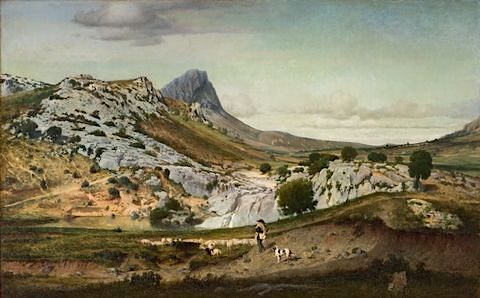JASPER FRANCIS CROPSEY (1823-1900)
Sugar Loaf mountain (347 meters - 1,138 ft)
United States of America (New York State)
In Autumn Landscape, Sugar Loaf Mountain, Orange County, New York, ca. 1870–75,
oil on canvas 90,2x72,4 cm) The MET Museum (not on view)
About this painting and the mountain Extract from an article by Kenneth W. Maddox, Art Historian, The Newington-Cropsey Foundation
Jasper F. Cropsey's paintings of Sugar Loaf Mountain are among the most problematic of his
works. The subject of many of these paintings has often been incorrectly identified because the geographic area is unfamiliar to both art historians and dealers; only three paintings with "Sugar Loaf' in the title are documented through exhibition or auction records.'An even more important factor, however, is that the artist took great liberties with his subject. Cropsey's portrayals of the mountain appear much more similar to one another than to the actual topography of the site: certainly, in terms of scale and contour, the prominent peak in his works does not closely resemble the one that rises in the Warwick Valley, Orange County, New York. Small wonder, then, that the title and subject of Cropsey's fall scene in The Metropolitan Museum of Art, known as Autumn Landscape, Mount Chocorua, New Hampshire, has not been challenged since the Museum acquired he painting in 1961(...)
In his paintings of Sugar Loaf (above), Cropsey transformed a mountain of fairly modest proportions and shape into a monumental form, which, like Mount Chocorua, majestically rises above the surrounding errain. It is a profound transformation-one that does not occur to this degree in any of the painter's other works-from the physical realities of the landscape to the mental creation of the artist. One may well ask, as with Cezanne's views of Mont Sainte-Victoire, what personal meaning the peak might have had for the artist. Although it is not mentioned in any of Cropsey's extant writings, this was a motif to which he was repeatedly drawn. Ironically, because of the liberties
Cropsey took in his portrayals of the mountain, Sugar Loaf has gone unrecognized-until now-as
the subject of numerous paintings.
The painter
Jasper Francis Cropsey (February 18, 1823 – June 22, 1900) was an important American landscape artist of the Hudson River School. Trained as an architect, he set up his own office in 1843. Cropsey studied watercolor and life drawing at the National Academy of Design under the instruction of Edward Maury and first exhibited there in 1844. A year later he was elected an associate member and turned exclusively to landscape painting; shortly after he was featured in an exhibition entitled "Italian Compositions".
Cropsey traveled in Europe from 1847–1849, visiting England, France, Switzerland, and Italy. He was elected a full member of the Academy in 1851. Cropsey was a personal friend of Henry Tappan, the president of the University of Michigan from 1852 to 1863. At Tappan's invitation, he traveled to Ann Arbor in 1855 and produced two paintings, one of the Detroit Observatory, and a landscape of the campus. He went abroad again in 1856, and resided seven years in London, sending his pictures to the Royal Academy and to the International exhibition of 1862.
Returning home, he opened a studio in New York and specialized in autumnal landscape paintings of the northeastern United States, often idealized and with vivid colors. Cropsey co-founded, with ten fellow artists, the American Society of Painters in Water Colors in 1866.
Cropsey's interest in architecture continued throughout his life and was a strong influence in his painting, most evident in his precise arrangement and outline of forms. But Cropsey was best known for his lavish use of color and, as a first-generation member from the Hudson River School, painted autumn landscapes that startled viewers with their boldness and brilliance. As an artist, he believed landscapes were the highest art form and that nature was a direct manifestation of God. He also felt a patriotic affiliation with nature and saw his paintings as depicting the rugged and unspoiled qualities of America.
______________________________
2020 - Wandering Vertexes...
by Francis Rousseau



















